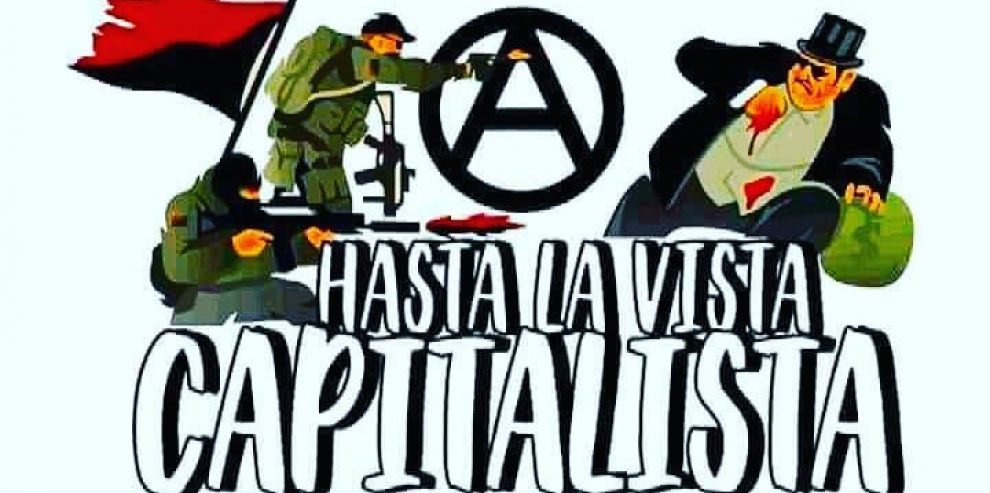This is the first in a short series of introductions to anarchist theory and practice. It assumes a basic understanding of anarchist theory, what it is, and what it isn’t.
Both Insurrectionary and Mass anarchism are tendencies within anarchist thought and practice, differing massively, below we lay out those differences.
Insurrectionist Anarchism can be summarised into 5 points.
1.)Generally illegalist in orientation.
2.)Focuses on direct action and the potential for escalation of events.
3.)Small scale, decentralised, Informal or minimal forms of organisation.
4.)Emphasises immdediate action and initiative over ”waiting for the masses”.
5.)Views revolution and insurrection to be a long term, but spontaneous process, insperable from one another from the beginning, but viewing the insurrectional process and capacity, as central to a revolutionary movement.
Points 1, 2 and 3 are all strongly interconnected, with the need for small scale, secretive organisation because of the nature of illegal direct action (it could land you in jail).
Mass anarchism can be summarised into 5 general concepts.
1.)Generally safe, legalistic in practical orientation, while often advocating for vague, ”direct action” politics.
2.)Focuses on reformist campaigns, building their democractic, open and mass (large scale) nature.
3.)Organised through open, legal, formal and (ideally) large scale federations involving many individuals.
4.)Very sceptical of small actions, especially militant ones, favouring a historical view of revolution being a sudden burst forth, and not an incremental, lived reality of live struggle.
5.) Views numerical quantity of membership as being a central aim, instead of the quality of the activity.
Mass anarchist get involved in community campaigns, trade unions (syndicalism) and single issue movements. Insurrectionist anarchists generally focus on tactics like sabotage, riots, expropriation and property destruction.
Serious difference exist between the types of propaganda the two groupings carry out.
Mass anarchist use written documents like, leaflets, papers and articles, while insurrectionary anarchists use their direct actions as propaganda in themselves, as ways of grabbing public attention–they are twofold in their use. Direct action helps campaigns against capitalists ect. but it also serves as propaganda and inspiration.
Each group accuses the other of a series of faults in theory and practice.
Insurrectionary anarchists are critical of large scale, formal federations as they say they inherently lead to representative forms of ”democracy”, bureaucracy, centralisation and fundamentally are the embyros of new power systems. Mass anarchists simply ignore this reality or agree with it, state the answer is more ”democracy”. A full length critique of mass democracy is too come.
Mass anarchist accuse the insurrectionists of being ”adventurists”,”agent provocateurs”, of not understanding the complexities of revolution, of utilisng ineffective organising techniques, of reducing revolution to force and of bringing repression down on the anarchist community as a whole.
Insurrectionary anarchists reply by accusing the mass anarchist of being closest reformists, who refuse to take the necessary steps to build a movement with teeth, of failing to recognise that an anarchist movement which cannot sustain repression is worth little, of being stuck in dogmatic, academic theory and tactics well over 100 years old, of being ineffective, and of building, through unions and formal organisations, the structures of repression of the future.
The last point is generally a reference to the CNT-FAI’s collaboration with the Spanish state and the wave of repression they facilitated against grassroots insurrectionary anarchists.
While some anarchists view these two movements to be overlapping and mutually reinforcing, the reality is there methods are so at loggerheads that they should be viewed a separate movements or tendencies. Mass anarchist organisings’ cautious, legalistic and open approach leaves police surveillance and intelligence gathering to be an easy process, while inherent to insurrectionary anarchists activities is a degree of attack-repression and police harassment.
The two methods are contradictory and will always come to loggerheads. They both have almost opposing views on insurrection and revolution that should not be swept under the rug.
Their difference can be summed up here.
Minimal vs. formal, mass organisations.
Escalate immediately vs. wait.
Insurrection vs. reform.
Quality vs. quantity.
Anarchy vs. representative democracy
Illegalist vs. Legal
Direct action vs protest
Individualist& social struggle vs collectivist struggle.
These are not minor points of disagreement, and its not surprising the two groups clash as often.
Choose you side as you will.
